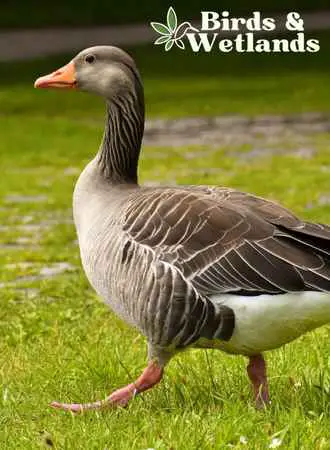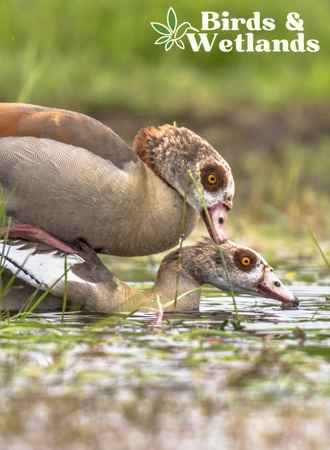The Taiga Bean-goose is one of the rarest birds in North America. It was first observed in 1804, and it has been spotted only a handful of times since then. It is also known as the Bean Goose, Jack Snipe Goose, or Buff-breasted Goose.
Scientific Name: Anser fabalis
Length: Length ranges from 68 to 90 cm (27-36 in)
Wingspan: 140 to 174 cm (55–69 in)
Weight: 1.7–4 kg (3.7–8.8 lb)
Taiga Bean-Goose Description
The Taiga Bean Goose is a medium-sized goose species with distinctive brown plumage and bright orange legs. The bill is black at the base and tip, with an broad orange band running down the center. The bird has a brown head, back, neck, and breast, with paler brown feathers on the underparts. Its underwing is dark, while its tail is also dark with white edging.
The upper wing coverts are dark brown, similar to the Greater White-fronted Goose (Anser albifrons) and the Lesser White-fronted Goose (Anser erythropus), but differ in that the feathers have narrow white fringes.
The Taiga Bean Goose’s wings have broad white lines along the back, created by the contrast between the dark-colored feathers and their pale edges. Additionally, this species of geese have black bills with an orange subterminal band and dark eyes. Males and females are similarly colored and sized, though males tend to be slightly larger than females.
The plumage of juveniles is slightly duller than adults, but it retains the distinct brown coloration.
The taiga bean-goose is closely related to the pink-footed goose (A. brachyrhynchus), which has a short, bright pink bill in the middle, pink feet, and upper wing-coverts that are nearly the same bluish grey as the greylag goose. In flight, the taiga bean-goose lacks contrasting pale forewing areas of the Pink-footed Goose and Graylag Goose, which was considered the sixth subspecies of the bean goose in the past.

Difference Between Taiga Bean-Goose and Tundra Bean-Goose
The taiga bean goose and the tundra bean goose (Anser serrirostris) are two types of gooese best known for their similar appearance. While these geese share many physical characteristics that make them difficult to distinguish, some key differences in their behavior and habitat set them apart. The two species are primarily separated based on their breeding habitat.
The taiga bean goose is typically found inhabiting open fields in temperate regions like Europe and Asia. In contrast, the tundra bean goose prefers colder climates like those in northern latitudes.
The habitat differences between the taiga bean-goose and the tundra bean-goose have resulted in several distinct behavioral differences between the two birds, including feeding strategies and mating patterns.
While these species may differ significantly in many ways, what ultimately sets them apart is their ability to adapt to varying environments. These geese have evolved diverse strategies to survive harsh conditions, such as those they often find themselves in throughout their respective ranges.
And while they may continue to show similar physical characteristics such as the bill structure that can make distinguishing between them difficult at first glance, deeper observation can help reveal their unique traits over time.

Five Subspecies of Bean Goose
There are five subspecies of the bean goose with complex variation in bill size, body size and plumage pattern.
A. f. fabalis – found in Scandinavia east to the Urals
A. f. johanseni – found in West Siberian taiga
A. f. middendorffii – found in East Siberian taiga
Anser fabalis rossicus – found in Northern Russian tundra east to the Taimyr Peninsula
A. s. serrirostris – found in East Siberian tundra (long bnill with narrow orange band)
Listen to Taiga Bean-Goose
The Taiga bean-goose is known for its loud honking, higher pitched in the smaller subspecies, while in flight.
Taiga Bean-Goose Habitat
The Taiga Bean Goose is a distinct species of goose that is well adapted to habitats in the tundra and taiga regions. During breeding, these geese typically prefer to nest in forest bogs and tundra areas near open marshes and lakes. These locations provide dense vegetation for protection from predators and serve as excellent feeding grounds, as they support many aquatic plants that are ideal for keeping a goose’s diet.
During the winter months, Taiga Bean Geese are often seen frequenting agricultural lands and lakes and marshes, where food is more abundant. Their flexible habitat affords them security against fluctuations in food availability, which makes this goose species resilient and able to survive even under less-than-ideal conditions. Thus it remains one of the most common geese species in its natural range today.

Taiga Bean-Goose Range
The population range of the taiga bean goose is extensive, spanning several continents and regions. This migratory bird typically breeds in northern parts of Eurasia, including Russia (Western Siberia), Finland, Sweden, Norway, and Iceland.
During the cold winters, their regular wintering sites can be found in north and western Europe, Iran, Northwest China, Central China, Japan, and much of Southeast Asia. Additionally, due to their habitat ranging across such a large area, it is considered a rare but regular visitor to the Aleutian Islands and Bering Sea region of Alaska during their spring migration.
This goose is a rare winter visitor in Great Britain but there are two regular wintering flocks in the Yare Valley, Norfolk and the Avon Valley, Scotland. A formerly regular flock no longer occurs in Galloway, Dumfries and some parts of the British Isles.
With its broad distribution across several different ecosystems and climates, the taiga bean goose is an incredibly adaptable species that has managed to thrive in various environments.

Taiga Bean-Goose Range Diet
Taiga bean-goose’s diet is varied and consists primarily of plant materials such as grass, seeds, corn, rice, barley, wheat, soybeans, potatoes and sugar beets.
The taiga bean-goose typically forages by walking on dry land and in wet areas near lakes and marshes, depending on its range and the season. This goose feeds on a wide variety of grasses, leaves, roots, tubers, seeds, grains, nuts and other plant matter to meet its nutritional needs.
Taiga Bean-Goose Nesting & Mating Habits
During the breeding season, taiga bean-geese typically select nesting grounds near wetlands or other areas with abundant moist, fertile soil. The nests are usually constructed from nearby materials, such as mosses, grasses, leaves, and other plant matter.
In choosing optimal nesting sites, female taiga bean geese also play a key role in caring for the eggs and young. After laying between 4-6 eggs, they will incubate them for approximately 27-29 days while both male and female geese provide food for their growing offspring. Once the chicks have hatched and become mobile, they remain dependent on their parents for several weeks before eventually branching out independently.
Many taiga bean geese have been observed to join flocks of tundra bean geese and other geese.

Taiga Bean-Goose Population & Conservation Status
The Taiga Bean Goose is a widely distributed goose species found throughout northern Europe, Asia and northern parts of North America.
Although the current conservation status of the taiga bean goose is Least Concern and they are not yet considered a threatened species, these waterfowl ‘s global population continues to decline each year due to habitat loss for agriculture and development, oil pollution and pesticide use. Global warming and civil persecution are also serious problems facing this species. Other species of geese face the same challenges.
All these challenges contributed to the declining taiga bean goose population, estimated at around 680,000-800,000 individuals worldwide. Although it is not currently considered threatened on a global scale, continued monitoring and conservation efforts are needed to protect the habitat of this unique bird species.

Key Takeaways
- The tundra bean goose is closely related to the pink-footed goose, taiga bean goose, and greylag goose.
- The tundra bean goose primarily feeds on plant material.
- The tundra bean goose is a migratory bird and is considered a vagrant species in North America.


